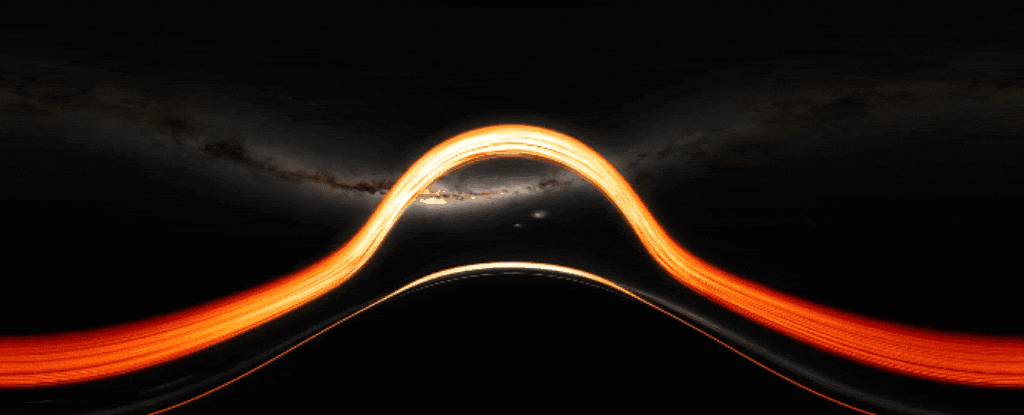Products You May Like
It’s a question that has dogged humanity since we first learned about black holes a little over a century ago: What the heck would it be like to plunge beyond the point of no return?
We still don’t have an answer, but a new supercomputer simulation is the best guess we have, based on current data.
“People often ask about this, and simulating these difficult-to-imagine processes helps me connect the mathematics of relativity to actual consequences in the real Universe,” says astrophysicist Jeremy Schnittman of NASA’s Goddard Space Flight Center.
“So I simulated two different scenarios, one where a camera – a stand-in for a daring astronaut – just misses the event horizon and slingshots back out, and one where it crosses the boundary, sealing its fate.”
frameborder=”0″ allow=”accelerometer; autoplay; clipboard-write; encrypted-media; gyroscope; picture-in-picture; web-share” referrerpolicy=”strict-origin-when-cross-origin” allowfullscreen>
The unknowable is like a flame to the moth of our curiosity, and black holes could well be the poster child for the unknowable. Formed from the cores of massive dead stars collapsing under their own gravity, they’re so dense that their matter compresses into a space that is currently indescrible to physics.
One result of this compression, however, is an event horizon; a roughly spherical boundary where the pull of gravity is so strong that not even light speed is sufficient to achieve escape velocity.
This means we have no way of knowing what’s beyond an event horizon. Light is the main tool we use to probe the Universe. If we can see no light from inside a black hole, we just… can’t tell what’s there.
Even in theory, we run into paradoxes where information is both preserved on the event horizon from the point of view of an observer and locked away forever from the point of view of an object crossing the boundary.
What we do know, however, based on the way light and matter moves around black holes, is that the gravitational regime around the event horizon is just absolutely bananas. In some cases, anything that ventures too close gets pulled to atoms by the extremity of the forces involved. The exact point at which that happens depends on the mass of the black hole involved – stellar-mass, or up to around 100 Suns in mass; or supermassive, millions to billions of solar masses.
frameborder=”0″ allow=”accelerometer; autoplay; clipboard-write; encrypted-media; gyroscope; picture-in-picture; web-share” referrerpolicy=”strict-origin-when-cross-origin” allowfullscreen>
“If you have the choice, you want to fall into a supermassive black hole,” Schnittman says.
“Stellar-mass black holes, which contain up to about 30 solar masses, possess much smaller event horizons and stronger tidal forces, which can rip apart approaching objects before they get to the horizon.”
Incredible breakthroughs in recent years have given us a wealth of data on the space around black holes. Supermassive black holes M87* and Sagittarius A*, at the centers of galaxies M87 and our own, respectively, were the subjects of amazing direct imaging campaigns. The black hole itself is still invisible, of course, but the light emitted by the roiling, glowing clouds of material around each black hole have given us an unprecedented insight into the gravitational environment.
Schnittman, who has produced several black hole simulations for NASA, based his new one on a supermassive black hole very similar to Sagittarius A*. He started with a black hole with a mass equivalent to about 4.3 million Suns, and, together with data scientist Brian Powell, also of Goddard, fed their data into NASA’s Discover supercomputer.
frameborder=”0″ allow=”accelerometer; autoplay; clipboard-write; encrypted-media; gyroscope; picture-in-picture; web-share” referrerpolicy=”strict-origin-when-cross-origin” allowfullscreen>
After running for five days, the program had generated 10 terabytes of data, which the scientists used to create several videos of what it might feel like to fall into a supermassive black hole. On a typical laptop, this would have taken 10 years.
The simulated camera starts around 640 million kilometers (400 million miles) from the black hole, and moves in. As it approaches, the disk of material around the black hole and an inner structure known as the photon ring become clearer.
These elements, and space-time, grow more distorted the closer the camera grows. Finally, the flight performs nearly two orbits of the black hole before plunging beyond the event horizon, and getting spaghettified after just 12.8 seconds.
In the other version, the camera veers close to the black hole, before escaping the gravitational pull and flying away.
It would be nice to think that, at some point, we might learn more about the environment beyond the event horizon. In the meantime, we can enjoy a taste of the wacky space-time antics that would exist around its perimeter – and all from the safety of our own home planet.
